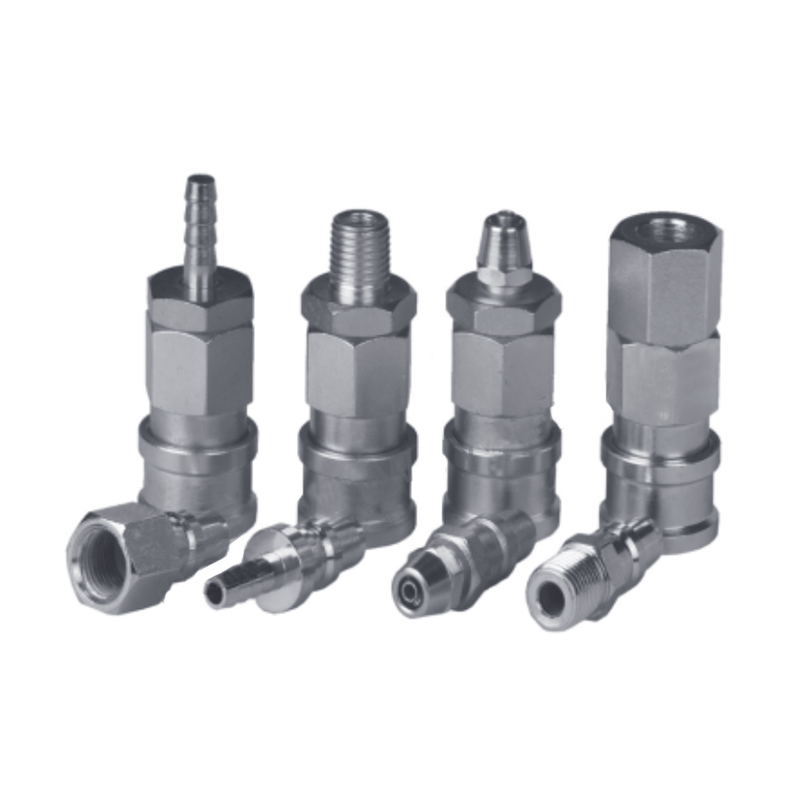What are the potential risks associated with improper installation or usage of pneumatic quick couplings?
Improper installation or usage of pneumatic quick couplings can lead to various risks, affecting both the equipment and the safety of personnel. Here are some potential risks associated with improper installation or usage of pneumatic quick couplings:
1.Air Leakage:
Risk Description: Improper installation techniques or damaged seals within pneumatic quick couplings can result in air leakage. Even minor leaks can cause a significant loss of system efficiency and negatively impact the performance of connected pneumatic components.
Impact: Reduced operational efficiency, increased energy consumption, and potential malfunctioning of downstream equipment.
2.Pressure Drops:
Risk Description: Incorrectly installed or poorly matched couplings can lead to pressure drops within the pneumatic system. Pressure inconsistencies can compromise the functionality of connected devices, leading to suboptimal performance and reduced overall productivity.
Impact: Decreased efficiency, slower response times, and compromised performance of pneumatic machinery and tools.
3.Safety Hazards:
Risk Description: During improper installation, airborne contaminants or foreign particles might enter the system, leading to damage of sensitive components. In extreme cases, forceful ejection of debris can pose significant safety hazards to personnel working in proximity.
Impact: Increased risk of injury, equipment damage, and compromised product quality in sensitive manufacturing processes.
4.Damage to Components:
Risk Description: Misaligned or forcibly connected couplings can cause physical damage to both the coupling and the mating components. This can result in accelerated wear and tear, leading to frequent maintenance requirements and increased operational costs.
Impact: Increased maintenance costs, extended downtimes, and potential replacement of damaged components.
5.Fittings Separation:
Risk Description: Insufficiently secured couplings, especially in high-pressure systems, can unexpectedly disconnect, leading to uncontrolled air release and potential harm to operators. This scenario is particularly hazardous in applications requiring constant, reliable pressure.
Impact: Risk of injury, damage to surrounding equipment, and potential disruption of operations.
6.Incompatibility:
Risk Description: Mismatched flow rates or pressure ratings between couplings and connected components can result in incompatibility issues. This can cause stress on components, compromising their structural integrity and leading to premature failure.
Impact: Damage to components, increased maintenance frequency, and compromised system reliability.
7.Corrosion:
Risk Description: In corrosive environments, using couplings made from materials lacking corrosion resistance can lead to rapid degradation. Corrosion weakens the structural integrity of the couplings, potentially causing leaks or complete failure.
Impact: Decreased operational lifespan of couplings, increased risk of leaks, and potential contamination of products or processes.
8.High Temperatures:
Risk Description: In applications with elevated temperatures, selecting couplings not designed to withstand these conditions can lead to seal degradation and material failure. This can result in leaks, system inefficiency, and compromised safety.
Impact: Increased risk of system failure, decreased operational efficiency, and potential safety hazards due to hot air or steam release.
9.Fluid Contamination:
Risk Description: Using incorrect couplings in applications involving specific fluids can lead to contamination. Contaminated fluids compromise the quality of the end product, damage downstream equipment, and disrupt manufacturing processes.
Impact: Compromised product quality, increased maintenance and cleaning efforts, and potential harm to equipment and machinery.
10.Improper Venting:
Risk Description: Inadequate venting practices can lead to pressure build-up within the system, causing unexpected movements or disconnections. This can be especially dangerous in applications where sudden releases of pressure can cause uncontrolled movements.
Impact: Risk of injury, equipment damage, and disruption of operations due to unexpected movements or disconnections.
QKD153 Steel Single disconnect pneumatic quick air fittings are a type of air fitting used to connect and disconnect pneumatic hoses or tubes quickly and easily. These fittings are designed for use in pneumatic systems, which use compressed air or gas to transmit power or control signals.












Contact Us